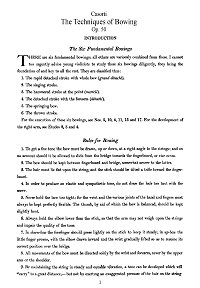Casorti - The Techniques of violin Bowing Op. 50
|
Casorti - The Techniques of violin Bowing Op. 50. You can download the PDF sheet music Casorti - The Techniques of violin Bowing Op. 50 on this page. THERE are six fundamental bowings; all others are variously combined from these. I cannot too urgently advise young violinists to study these six bowings diligently, they being the foundation of and key to all the rest. They are classified thus:
- The rapid detached stroke with whole bow {grand détaché).
- The singing stroke.
- The hammered stroke at the point {martelé).
- The detached stroke with the forearm (détaché).
- The springing bow.
- The thrown stroke.
For the execution of these six bowings, see Nos. 5, 10, 4, 11, IS and 17. For the development of the right arm, see Études 2, 3 and 4.
To download PDF, click the "Download PDF" button below the appropriate sheet music image.
To view the first page of Casorti - The Techniques of violin Bowing Op. 50 click the music sheet image.
|
| PDF format sheet music |
|
|
|
Instrument part: 23 pages. 1728 K
|
Piano part: Missed
|
 |
 |
|
|
| Download PDF (14.99
€) |
|
|
Rules for Bowing
1. To get a fine tone the bow must be drawn, up or down, at a right angle to the strings; and on no account should it be allowed to slide from the bridge towards the fingerboard, or vice versa.
2. The bow should be kept between fingerboard and bridge, somewhat nearer to the latter.
3. The hair must lie flat upon the string, and the stick should be tilted a trifle toward the fingerboard.
4. In order to produce an elastic and sympathetic tone, do not draw the hair too taut with the screw.
5. Never hold the bow too tight; for the wrist and the various joints of the hand and fingers must always be kept perfectly flexible. The thumb, by aid of which the bow is balanced, should be kept slightly bent.
6. Always hold the elbow lower than the stick, so that the arm may not weigh upon the strings and impair the quality of the tone.
7. In down-bow the forefinger should press lightly on the stick to keep it steady; in up-bow the little finger presses, with the elbow drawn inward and the wrist gradually lifted so as to resume its correct position over the bridge.
8. All movements of the bow must be directed solely by the wrist and forearm, never by the upper arm or the shoulder.
9. Bv maintaining the string in steady and equable vibration, a tone can be developed which will "carry" to a. great distance,— but not by exerting an exaggerated pressure of the hair on the string
|
|